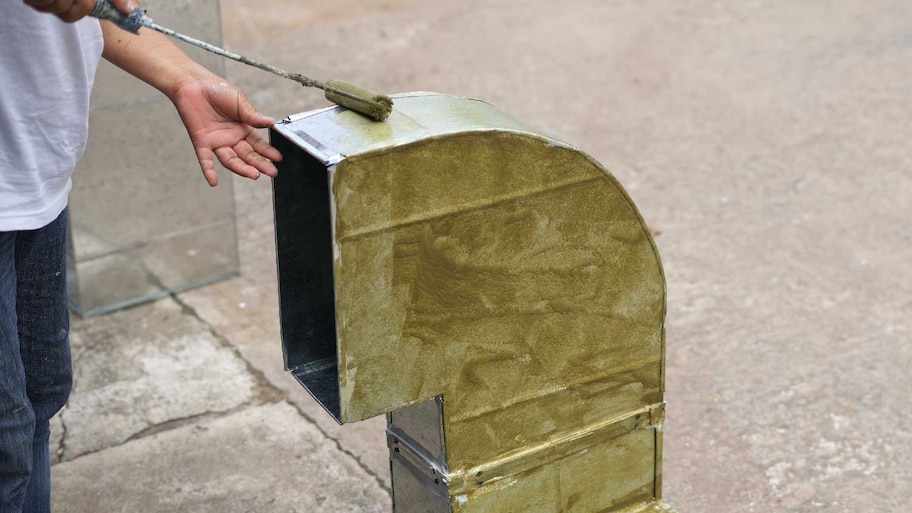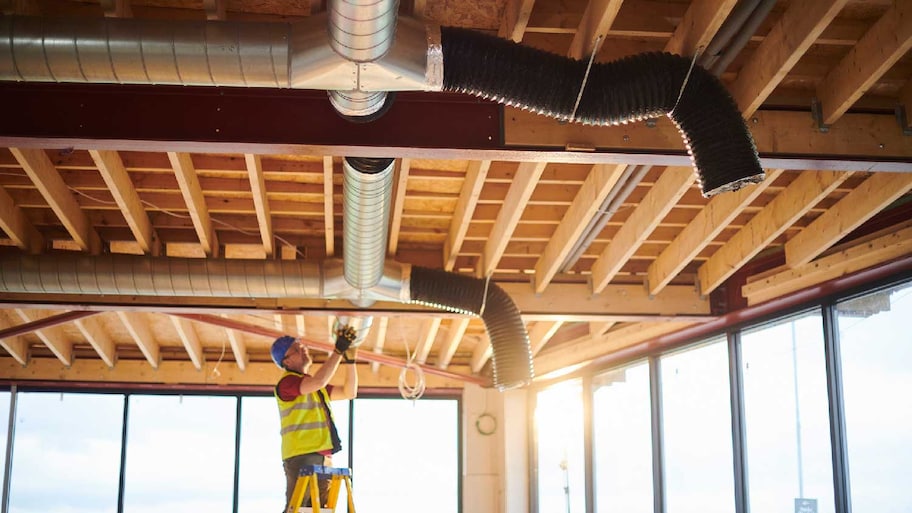Can You Paint Ductwork? Everything You Need to Know
Jazz up home offices by painting exposed ducts


Highlights
Painting ductwork can beautify it and protect it from corrosion.
You need paint and primer specific to the type of ducts you have.
The job can take days, most of which is drying time between coats and steps.
Exposed metal ductwork can be an eyesore that clashes with your dream living room. But if industrial chic isn't your style, fear not. Not only is painting your ductwork possible, it can even protect it from corrosion. We'll walk you through how you can paint ductwork to make it part of your decor.
Why Paint Ductwork?
The main reason you may want to paint your ductwork is if it’s exposed rather than hidden. Painting exposed ductwork can help camouflage it with the walls and ceiling, making it more aesthetically pleasing. If your ductwork is not exposed, there’s no need to paint it.
However, some people prefer to leave exposed ductwork unpainted so their home has an intentional industrial look. While exaggerating the industrial appearance of exposed ducts is more common in commercial spaces than homes, stylizing duct work presents numerous options for making them part of a room instead of an awkward background object.
Even if aesthetics are your primary goal in painting ductwork, there are maintenance advantages, too. Older ducts can make your home look rundown. Adding a fresh coating can make the ducts look cleaner and more modern, but it also prevents corrosion that comes from within. Removing tarnished spots in the process is another upside.
Paint Type by Duct Material

Most ducts are made of metal—most often, galvanized steel. However, ductwork can be made of various materials, including plastic. Different types of ductwork require paints that are chemically safe for them. Here are the best types of paint to use on different kinds of ductwork.
Galvanized Steel Ducts
Alkyd paint is the best choice for galvanized steel. It's more durable than latex, retains its shine for an incredibly long time, and it can easily adhere to most surfaces. Alkyd paints are also resistant to abrasion, rust, and corrosion, which makes them the go-to paint for metal surfaces.
Fiberglass Ductwork
Heat-resistant epoxy paint is your best choice because it can adhere to fiberglass easily and will last for several years without needing to be recoated.
Plastic Ducts
Latex paint works well on plastic since it's essentially a type of plastic on its own.
Can You Spray Paint Ductwork?
Spray paint works well on most ducts, but before spray painting, make sure you have protective gear and plenty of painter's tape and plastic sheets. The area should also be properly ventilated with box fans, and don’t forget your respirator. One big benefit of using spray paint on ducts is that it’s easy to reach awkward areas.
It’s also safe to use spray paint on heat registers. Just like with preparing ducts for painting, you need to remove and clean the registers first. Take additional caution based on the register's material. Zinc can oxidize and create extra dust that needs to be cleaned first before you can prime it. Prime it with a metal-graded primer, and after it dries, spray paint in a well-ventilated area.
Ductwork Painting Tips and Precautions
Ready to go? There are a few things you should do before you start painting your ductwork.
Check for leaks. Imperfections are one thing but don't start this job if your ducts are cracked or need duct sealing. A DIY duct leakage test can help you determine if it's safe to proceed, but if your ducts are particularly old, you may opt for a professional inspection before gathering painting supplies.
Pick a color that will blend. The best way to pick a paint color for ducts is to focus on colors that match your walls and ceilings. Neutral colors like white and taupe tend to look the best on exposed ductwork, but many people like black paint's bold, modern look.
Prepare the surface. Before painting, use basic household cleaners and a rag to wipe dust and dirt off the ducts' surface. Oily deposits on the ducts can also interfere with paint adherence, so you should remove them with mineral spirits. You can also rub white vinegar on metal ducts after cleaning them, to make them more receptive to paint.
Prime the surface. You'll need to get primers specific to the surface that you're painting. If you're painting galvanized metal ducts, an oil-based primer designed for metal usage is the primer for this job. If your ducts get hot, it’s crucial to get a primer that can withstand high temperatures.
Protect yourself from fumes. Ventilate the room before you work so you don’t inhale dangerous fumes. Open windows and set up a box fan to keep the air as fresh as possible while you paint. You should also wear a face mask.
These steps can take hours at a time. Ducts that are still wet from cleaning need to completely dry first. Primer can take two to four hours to dry before you can start painting. If you’re painting ductwork in the basement or other moist areas with little natural ventilation, it can easily take four to six hours or longer to dry between coats.
DIY vs. Hiring a Pro to Paint Ductwork

Painting ductwork poses different challenges than painting a room in your home. It can be difficult to determine which paint and primer is best for your ducts, or if it’s safe to paint them after cleaning. Your local duct installer can assist with interior duct cleaning and inspection before you start the job, but is it worth it to paint the ducts yourself or hire a professional painter?
Most primers cost around $10 per gallon, with interior-grade paint ranging from $15 to 40 per gallon. Painters charge $20 to $50 per hour for labor, which you may find worth it if you’re not sure which coating solutions are safe to use on your type of ductwork.
If you get paint inside the ducts doing it yourself, it can create a very expensive mess that creates unbreathable air. Mistakes with painting ductwork can be costly and harmful, especially if your ducts malfunction after using primer or paint that wasn’t designed for its temperature or materials. If your painting jobs resemble abstract pour art, you might want to leave this to the professionals. Getting paint inside a canvas frame is fine. It’s not fine if it gets inside the duct.
There are some logistical challenges with finding a local painter. You may need to look at painting services that handle commercial jobs and have all the right tools for painting different types of ductwork.
